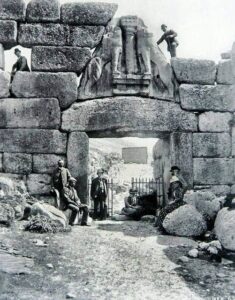Table of Contents
Toggle1. Introduction to the Lion’s Gate – The Grand Fortress of the Mycenaean Civilization
The Lion’s Gate at Mycenae, Greece, stands as a hallmark of Mycenaean civilization, constructed around 1250 BC. It served not only as the main gate to the Mycenaean citadel but also as a symbol of power, strength, and the unique architectural techniques of the ancient period. As a prime example of Cyclopean masonry, the gate was built from enormous limestone blocks joined without mortar, giving it a grand and enduring presence that has lasted for thousands of years.
2. Architecture of the Lion’s Gate – A Marvel of Cyclopean Masonry
The Lion’s Gate was built from massive limestone blocks, each weighing several tons, using a construction technique known as Cyclopean masonry. According to mythology, this style was inspired by the belief that only giants (Cyclopes) could have moved stones of such colossal size. This unique method gave the gate a lasting durability and distinctive aesthetic.
a. Key Feature: Symmetrical Lion Relief
At the top of the gate is a relief depicting two lions in a symmetrical stance flanking a central column, holding deep symbolic meaning. This relief is one of the few remaining large stone carvings from prehistoric Greece. The lions represent royal power and protection, while the central column signifies divinity or the authority of the king, ruler of Mycenae.
b. Engineering Breakthrough: Load-Bearing Strategy
The Lion’s Gate construction was designed to minimize pressure on the gate by creating a triangular space above it. The lion relief is placed within this triangle, serving both a decorative purpose and as a means of reducing the weight on the gate below, ensuring stability despite the enormous stones overhead.

3. Symbolic Meaning and Cultural Importance
The Lion’s Gate was more than a defensive structure; it held deep symbolic meaning related to the power and spirituality of Mycenae. The presence of lions and the central column could be linked to divine protection, reflecting the supreme authority of Mycenaean kings and the city as a major political and religious center.
a. Power and Majesty
The grand entrance with lions instills a sense of awe and power for anyone entering the city. It conveys the king’s authority, symbolizing an inviolable space protected by supreme strength.
b. Religious and Spiritual Symbolism
Scholars believe that the central column might represent a temple or deity worshiped within the city, adding a religious dimension to the gate. This shows that the Lion’s Gate was not just a military structure but also a sacred emblem, bridging the human and divine realms.

4. Architectural Legacy and Influence on Future Generations
The Lion’s Gate is one of the most significant architectural monuments of ancient Greece, greatly influencing architecture and sculpture in later periods, including classical Greek architecture. The Cyclopean masonry style, with its large stone blocks and symbolic elements, became a source of inspiration for many structures throughout European architectural history.
5. Conclusion
The Lion’s Gate at Mycenae is more than a mere entrance; it is a monumental symbol of ancient civilization. From its unique construction techniques to its deep spiritual meaning, this structure showcases the skill and creativity of the Mycenaean people. Today, the Lion’s Gate continues to attract visitors from all over the world, as a vivid symbol of an ancient era, providing us with a deeper understanding of the values and artistic vision of our ancestors.
